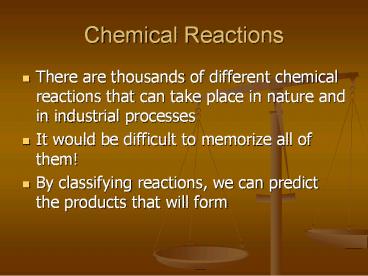Chemical Reactions - PowerPoint PPT Presentation
1 / 27
Title:
Chemical Reactions
Description:
Chemical Reactions There are thousands of different chemical reactions that can take place in nature and in industrial processes It would be difficult to memorize all ... – PowerPoint PPT presentation
Number of Views:99
Avg rating:3.0/5.0
Title: Chemical Reactions
1
Chemical Reactions
- There are thousands of different chemical
reactions that can take place in nature and in
industrial processes - It would be difficult to memorize all of them!
- By classifying reactions, we can predict the
products that will form
2
Types of Reactions
- These are the types of chemical reactions we will
talk about - Synthesis reactions
- Decomposition reactions
- Single displacement (replacement) reactions
- Double displacement(replacement) reactions
- Combustion
- You need to be able to identify the type of
reaction and predict the product(s)
3
Steps to Writing ReactionsStep 1
- Identify the type of reaction from clues that are
available. Write a word equation. - Example The combustion of methane gas in air
forms water and carbon dioxide. - Word equation
- Methane oxygen ? water carbon dioxide
4
Step 2
- Write a generic equation following the rules from
Reaction Types. - Write the reactants and products using
appropriate symbols and formulas. - Balance charges for ionic compounds using the
Common Ion Chart or Periodic Table. - Dont forget diatomic elements! (BrINClHOF).
- Example
- Methane oxygen ? water carbon dioxide
- CH4 O2 ? H2O CO2
5
Step 3
- Balance the equation by adjusting the
coefficients. - Example CH4 O2 ? H2O CO2
- Balanced CH4 2O2 ? 2H2O CO2
6
Step 4
- Confirm that the equation is balanced by checking
the number of atoms of each element on both sides
of the equation. - Example CH4 2O2 ? 2H2O CO2
- Reactants Products
- 1C 1C
- 4H 4H
- 4O 2O 2O 4O
- This equation is balanced!
7
1. Synthesis reactions
- Synthesis reactions occur when two substances
(sometimes elements) combine and form a compound.
(Sometimes these are called combination or
addition reactions.) - reactant reactant ? 1 product
- Basically A B ? AB
- Example 2H2 O2 ? 2H2O
- Example C O2 ? CO2
8
Synthesis Reactions
- Here is another example of a synthesis reaction
9
Practice
- Predict the products. Write and balance the
following synthesis reaction equations. - Sodium metal reacts with chlorine gas
- Na(s) Cl2(g) ?
- Solid Magnesium reacts with fluorine gas
- Mg(s) F2(g) ?
- Aluminum metal reacts with fluorine gas
- Al(s) F2(g) ?
10
2. Decomposition Reactions
- Decomposition reactions occur when a compound
breaks up into the elements or in a few to
simpler compounds - 1 Reactant ? Product A Product B
- In general AB ? A B
- Example 2 H2O ? 2H2 O2
- Example 2 HgO ? 2Hg O2
11
Decomposition Reactions when heated
- Metallic Carbonates give off metallic oxide and
Carbon Dioxide Li2CO3 ? Li2O CO2 - Metallic Hydroxides give off metallic oxide and
water Ba(OH)2 ? BaO H2O - Metallic Chlorates give off metallic chloride and
O2 2 NaClO3 ? 2 NaCl 3 O2 - Mineral Acids make water and nonmetal oxide
H2CO3 ? H2O CO2 - Metal Oxides release O2 2PbO2 ? 2PbO O2
- Electrolysis breaks compounds into elements
2KCl ? 2K Cl2
12
2. Decomposition Reactions
- Another view of a decomposition reaction
13
3. Single Replacement Reactions A BX ? B AX
- Active Metals replacing metals forming a
- salt. (Check the Activity Series) Na gt Ag
- Na AgNO3 ? Ag NaNO3
14
More Single Replacement Reactions
- Very Active Metals react w/ water releasing H2
and metallic hydroxide - (check Activity Series)
2K 2H2O ? H2 2KOH - Metals and Acids form H2 and salts
- Zn 2 HCl ? H2 ZnCl2
- Halogen-Halide Replacement (check
Activity Series) - F2 2RbBr ? Br2 2RbF
15
Single Replacement Reactions
- Aluminum metal reacts with Copper II Nitrate
- Al Cu(NO3)2 ?
16
4. Double Replacement Reactions
- Double Replacement Reactions occur when a metal
replaces a metal in a compound and a nonmetal
replaces a nonmetal in a compound - Compound compound ? product product
- AB CD ? AD CB
17
Double Replacement Reactions
- Think about it like foiling in algebra, first
and last ions go together inside ions go
together - Example
- AgNO3(aq) NaCl(s) ? AgCl(s) NaNO3(aq)
- Another example
- K2SO4(aq) Ba(NO3)2(aq) ? KNO3(aq) BaSO4(s)
2
18
Practice
- Predict the products. Be sure to check the
charges. Balance the equation - HCl(aq) AgNO3(aq) ?
- CaCl2(aq) Na3PO4(aq) ?
- Pb(NO3)2(aq) BaCl2(aq) ?
- FeCl3(aq) NaOH(aq) ?
- H2SO4(aq) NaOH(aq) ?
- KOH(aq) CuSO4(aq) ?
19
5. Combustion Reactions
- Combustion reactions occur when a hydrocarbon
reacts with oxygen gas. - This is also called burning!!! In order to burn
something you need the 3 things in the fire
triangle1) Fuel (typically hydrocarbon)2)
Oxygen (supports combustion)3) Ignition energy
(spark or heat)
20
Combustion Reactions
- In general CxHy O2 ? CO2 H2O
- Products in combustion are ALWAYS carbon dioxide
and water. (although incomplete burning does
cause some by-products like carbon monoxide) - Combustion is used to heat homes (Methane, CH4)
and run automobiles (Octane, C8H18)
21
Combustion
- Example
- C5H12 O2 ? CO2 H2O
- Write the products and balance the following
combustion reaction - C10H22 O2 ?
5
8
6
22
Mixed Practice
- State the type, predict the products, check the
charges and balance the following reactions - BaCl2 H2SO4 ?
- C6H12 O2 ?
- Zn CuSO4 ?
- Cs Br2 ?
- FeCO3 ?
23
Solubility Table
24
Determining Reaction Types
25
Identifying Reactions and Predicting Products
26
Identifying Reactions and Predicting Products
27
Identifying Reactions and Predicting Products































